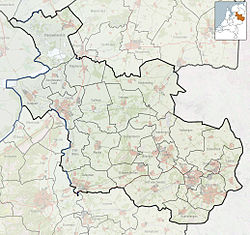Goor
Goor | |
|---|---|
City | |
 Sculpture: the history of Goor
| |
 Flag
 Coat of arms
| |
 Goor Location in province of Overijssel in the Netherlands
 Goor Goor (Netherlands)
| |
| Coordinates: 52°13′56″N 6°35′12″E | |
| Country | Netherlands |
| Province | Overijssel |
| Municipality | Hof van Twente |
| Area | |
| • Total | 19.49 km2 (7.53 sq mi) |
| Elevation | 12 m (39 ft) |
| Population
(2021)
| |
| • Total | 12,155 |
| • Density | 620/km2 (1,600/sq mi) |
| Time zone | UTC+1 (CET) |
| • Summer (DST) | UTC+2 (CEST) |
| Postal code | 7471
|
| Dialing code | 0547 |
Goor (pronounced [ɣoːr]) is a city in the Dutch province of Overijssel. It is located about 20 kilometres (12 mi) west of Enschede. Goor received city rights in 1263.
Goor was a separate municipality until 2001, when it became part of Hof van Twente. Goor had a statue of Joan Derk van der Capellen tot den Pol, but it was destroyed in 1787 by royalist Orangists in the defeat of the republican movement.
Jewish community
While records of individual Jews in Goor date back to the 14th century, the first permanent records of a Jewish community date to the 1600s when residence permits were issued to Jews.
The Joodse begraafplaats ('Jewish cemetery') of Goor on the Borghoek dates to 1720. The Jewish population expanded rapidly in the second half of the 18th century. In 1748, Goor had 13 Jewish residents; that number increased to 238 Jews by 1809. In 1821, the Jews of Goor joined together with Jews living in the neighboring towns of Diepenheim and Markelo to build the Ringsynagoge ('regional synagogue').
The Jewish community thrived throughout the 19th and early 20th centuries. Jews contributed to the economic development of Goor and the Twente region. The Jewish Lavino brothers set up a weaving school in Goor. Godfried Salomonson (1838–1911), a Jewish man, established the "Koninklijke Stoomweverij te Nijverdal" ('the Royal Nijverdal Steam Bleaching Works') in 1836 with the express purpose of serving as the center of the Dutch Industrial Revolution. In 1902, a new synagogue on Schoolstraat replaced the old Ringsynagoge.
As antisemitism gripped Nazi Germany in the late 1920s, Goor (like the rest of the Netherlands) saw an influx of Jewish refugees. The Nazis occupied the Netherlands in 1940. On March 24, 1945, Allied bombers hit and damaged the Goor Synagogue which had survived the Nazi occupation as a storehouse. During the war, nearly the entire Jewish community had been openly murdered or sent to concentration camps where they were killed.
In 1970, the Dutch government erected a national monument in the Joodse gemeenschap, memorializing the Jews whom the Nazis murdered.
Transportation
Railway Station: Goor
Notable people from Goor
- Erik Cent (1962), cyclist
- Rutger Kopland (1934–2012), poet
- Tommy Wieringa (born 1964), writer
- Jelle Klaasen (born 1984), darts player
- Renée Luth (born 1979), poet
- Hannie Rouweler (born 1951), poet
- Peter Veenhuizen (born 1964), orchestra conductor and composer
- Hinkelien Schreuder (born 1984), swimmer